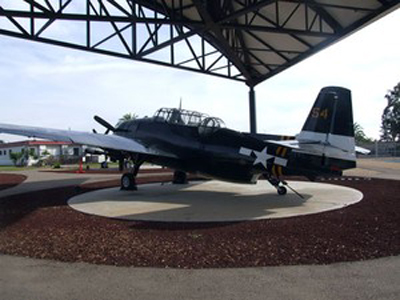
By Donald H. Harrison

MIRAMAR MARINE CORPS AIR STATION, California—There are two ways to visit a museum. You can browse the entire collection, getting a little knowledge about a lot of things. Or you can focus on a single exhibit, say, for example, a World War II carrier-based aircraft known as the Avenger.
Grumman Aircraft manufactured models that could drop a torpedo or a 2,000-pound bomb on the enemy.
Dick Miller, a retired lieutenant colonel who had gone through the enlisted and officer ranks during his 29-year career, actually had served as a radio operator aboard an Avenger, and was willing to share some of the plane’s lore with a visitor. Miller, today the volunteer coordinator at the Flying Leatherneck Museum, said the planes were still being used in the Korean War when he began in the service.
Miller pointed out that it was an Avenger that President George H.W. Bush—father of the current U.S. President—flew and crashed in the ocean during World War II operations in the Pacific Ocean.
“This was the first aircraft built that could carry a full torpedo in the belly of an aircraft; no other aircraft could do it,” Miller said.
It’s main mission was anti-submarine, but it was occasionally used against carriers and other surface ships. “It would just come in low and drop its torpedo and take out a ship,” Miller said. Then it would return to its own carrier and perhaps load on another torpedo for another run.
Sometimes, Miller said, a camera was substituted for the machine gun in the lower rear position to aid Avenger in its search for submarines.
“If they got a message from a ship that they were picking up something (enemy submarine activity) on the sonar, they would go over the surface of the water and they would be able to see the shadow of the submarine” even without sonar or other special tracking devices. “Many times I used to be able to fly off the coast of Florida and we would be able to see big sea turtles and manta rays out there all the time.”
The Avenger was 40 feet long, with a span of 54 feet 2 inches. It was 16 feet, 5 inches high requiring crew members to get a toe hold on the lower fuselage, then swing themselves onto the wing from which they could climb inside.
Avenger could fly at a maximum speed of 270 miles per hour, and climb at 1,425 feet per minute. Fully loaded it weighted 17,327 pounds, but without its crew and munitions it weighted only 10,534 pounds.
The Flying Leatherneck Museum is located in a bungalow building off Miramar Road. It is filled with posters, uniforms, and other Marine Corps memorabilia including some captured from enemy pilots. Avenger is parked in the back of the museum, amid some 30 other aircraft, each no doubt prompting memories of missions and personnel. The aircaft models bear such nicknames as “Corsair,” “Chickasaw,” “Seahorse,” “Huey,” “Sea Stallion,” “Cobra,” “Retriever,” “Sea Knight,” “Mitchell,” “Intruder,” “Bronco,” “Fagot,” “Hornet,” “Phantom,” “Skyhawk,” “Crusader,” “Cougar,” “Fury,” Skynight,” “Banshee” and “Texan.”
There is no charge for admission to the museum, but there is a large see-through container near the front-door where contributions are piling up to encourage the planned construction of a more modern and permanent museum expected to be built on an eight-acre parcel adjacent to the present site.
Susan Hathaway, the museum’s public affairs officer, said instead of in a bungalow the museum would be located in a 98,000-square- foot facility which would be opened May 22, 2012, a date marking the 100th anniversary of pioneer pilot A.A. Cunningham’s first flight from Annapolis in a Marine Corps craft.
“There are a lot of artifacts we don’t have here because it is too small,” Hathaway commented. Additionally, “the Retriever (a Pieseki HUP-2 H-25) doesn’t have its blades because they are wood and they wouldn’t hold up to the salt air.” Once the permanent building is completed, that helicopter and another which had wooden blades can be moved inside and the blades can be remounted.”
*
Harrison is editor of San Diego Jewish World. This article appeared previously on Examiner.com